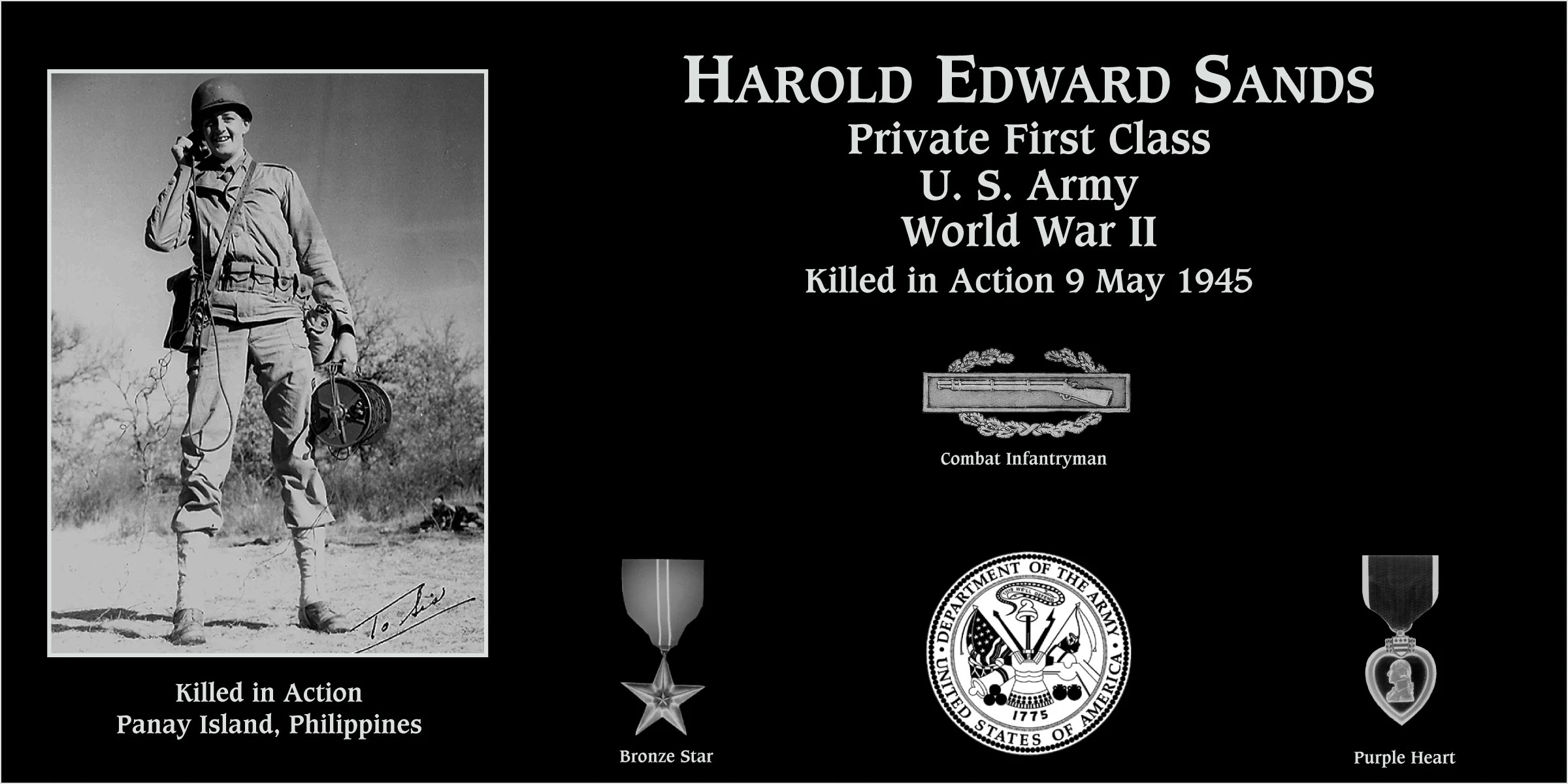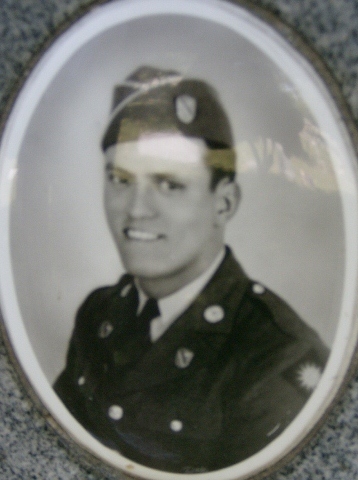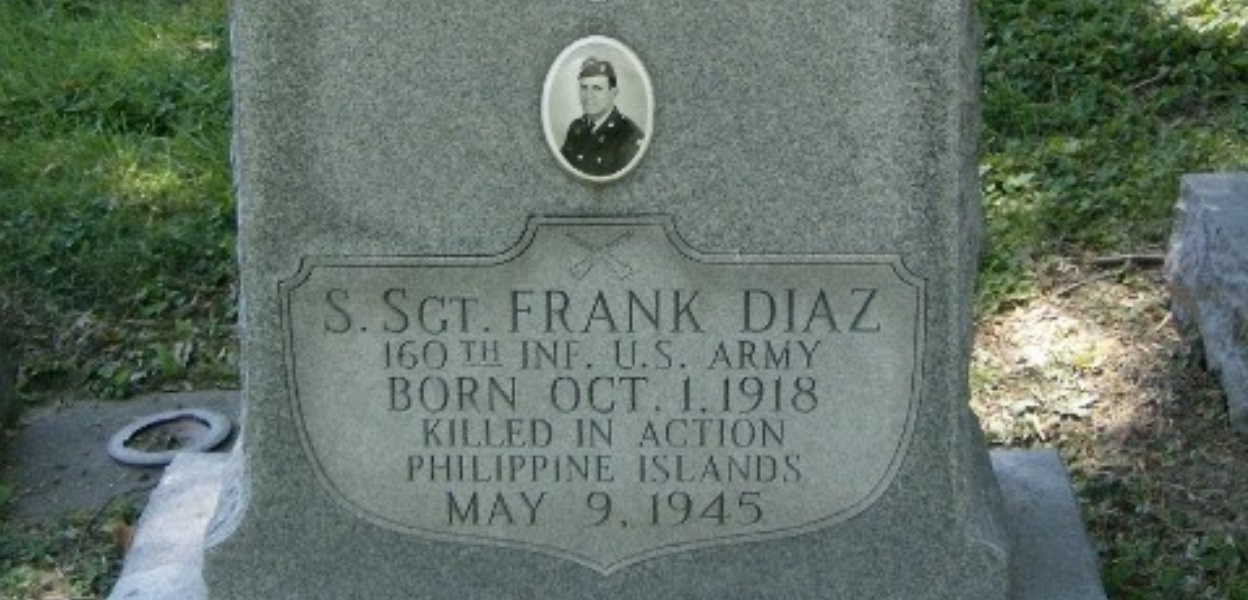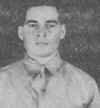When the 40th Infantry Division arrived in Iloilo on March 18, 1945, it was composed of 4 Infantry battalions. The 185th Infantry Regiment had all of its three battalions present while the 160th Infantry Regiment had only one battalion present, the "2nd Battalion." Its two other battalions would arrive later.
While the three battalions of the 185th Infantry Regiment marched to Iloilo City, the 2nd Battalion of the 160th Infantry Regiment raced to Cabatuan Airfield and the town of Cabatuan in a mechanized blitzkrieg lightning swoop, by way of Cordova, Leon and San Miguel, to liberate Cabatuan Airfield and Cabatuan. They arrived at Cabatuan that very night, at midnight.
See Blitzkrieg to Cabatuan.
Since then, they sent out patrols or detachments from Cabatuan whenever the Japanese presence was reported.
The 2nd Battalion 160th Infantry Regiment remained behind in Panay Island for garrison duty and for mopping up when the 40th Division moved on to Negros Island on March 29, 1945.
They apparently continued using Cabatuan as base of operations, for the subsequent events at Bocari (Leon) in April-May 1945 were described to have happened in the Cabatuan area.
Throughout the months of April and May, the 2nd Battalion, 160th Infantry, which had been left on Panay as garrison troops, made repeated contacts with enemy groups in the Cabatuan area.
- 40th Infantry Division
The barrio of Bucari.
The village of Bocari is at the foot of the outer rim of a depression around Mt. Inaman that peaked at about 1,350 meters. The outer rim of the basin measured about four kilometers east to west and two to three kilometers from north to south. On both sides of the 10-meter wide river, there were some 600 houses of villagers around terraced and skillfully irrigated rice fields.More Japanese soldiers trickle into Bucari.
- Lt. Toshimi Kumai
Everyday some Japanese soldiers managed to reach Bocari, exhausted, disheveled, and in rags. I met each one of them to hear the circumstances of Japanese soldiers killed in battle that they had spotted along the way.Japanese take positions at Bocari.
- Lt. Toshimi Kumai
The soldiers who had trailed behind thus came one after the other into Bocari.
- Lt. Toshimi Kumai
As everyone assembled, we decided on the positions of each of the forces. We could take a rest and regain physical health with abundant food, but we worried about the lack of ammunition. For the two mortars, there were only a dozen shells. Each soldier had only 140 to 150 bullets for their rifles. There were still a few thousand rounds for machine-guns but we did not have enough for a proper battle. All we could do was to pray that the enemy would not attack us.2nd Battalion 160th Infantry Regiment attacks Bocari in April and May 1945.
- Lt. Toshimi Kumai
Here (at Bocari) plans called for the construction of a permanent, self-supporting defense line in the hills bordering the Aganan River. When the construction of this line was underway, patrols were sent out on foraging expeditions in an effort to collect food.
- Lt. Sadayoshi Ishikawa
Throughout the months of April and May, the 2nd Battalion, 160th Infantry, which had been left on Panay as garrison troops, made repeated contacts with enemy groups in the Cabatuan area.The fighting begins in mid-April 1945.
- 40th Infantry Division
The Panay (Japanese) garrison had undergone, beginning about mid-April, intermittent enemy ground assaults supported by air and artillery bombardment. These attacks ceased altogether in late May.
- Reports of Gen. MacArthur, Japanese Operations in the Soutwest Pacific Area
April 15, 1945
Elements of the 2nd Battalion 160th Infantry Regiment approach Bocari.
At noon of the 15th of April 1945, an American force, estimated at company strength, approach the hills about one kilometer north of Bocari.Japanese troops prepare for combat.
- Lt. Sadayoshi Ishikawa
A large group of American soldiers – numbering more than a battalion–suddenly appeared on the plateau, about 500 meters in front of the Mizutani force.
- Lt. Toshimi Kumai
combat orders were issued.
- Lt. Sadayoshi Ishikawa
April 16, 1945
Americans begin bombarding Japanese positions with mortar fire.
The following morning the Americans (who, it was later learned, were under the command of Lieutenant Colonel James K. Marr) began bombarding our positions with mortar fire. Realizing the seriousness of the situation, Lieutenant Colonel Ryoichi Totsuka, commanding the 170th Independent Battalion, came forward personally to direct the defense.American mortar fire continue for three days, until April 18, 1945.
- Lt. Sadayoshi Ishikawa
From morning until night, they fired hundreds of mortar shells. Seen from the headquarters sited on the slope of Mt. Inaman, clouds of mud covered the position of the Mizutani force. All the sheltering foliage burnt to the ground and left the position unprotected.
- Lt. Toshimi Kumai
For the next three days efforts were made to neutralize our defenses with mortar fire but without success.Americans climb hills.
- Lt. Sadayoshi Ishikawa
For a few days more, the US forces patiently kept on shelling. We were envious of the large quantities of ammunition that they wasted.
- Lt. Toshimi Kumai
The US attack intensified when the position was exposed. At first, the barrage of mortar fire was preventing the soldiers of the Mizutani force from emerging from their trenches. Then, the American soldiers started climbing up the slope towards them. Because we were running out of ammunition, the Mizutani force did not retaliate even with a single bullet. The US soldiers came as close as a hundred meters from their position when, following the signal to ‘Fire!’, the Japanese soldiers began firing all at once. They were just sporadically firing their rifles, but the US soldiers ran back for their lives. Thus, the attack ended for the day.
- Lt. Toshimi Kumai
April 17, 1945
Americans continue shelling the Japanese.
The next morning, the Americans once again started shelling with mortars. This time, however, the shells had fuses that went off instantly. They largely left the trenches undamaged, producing holes on the ground only about 40 to 50 centimeters deep. The Mizutani force hid lying flat in the trenches during the shelling and observed this style of the enemy attack. When the firing ended, they ran up to their positions and waited for the Americans to approach. Soon, around two companies of US soldiers started to climb up the slope shooting their light machine-guns and carbines. We could distinguish each of their faces. They also looked tired from the tropical heat and steep mountains but continued to climb with determination. When they neared about a hundred meters, the Mizutani force started firing. The Americans retreated, stumbling down the hill, thus ending the morning attack. As expected, after lunch, the US forces started again and repeated the process.
- Lt. Toshimi Kumai
Eventually, we saw a crowd of American soldiers on the plateau about 500 meters ahead. Through binoculars, we could see them looking at us in a relaxed mood – smoking, chewing gum.
- Lt. Toshimi Kumai
April 18, 1945
Japanese decide to return fire.
We had withheld the use of heavy machine guns and mortars. However, since there was abundant game before us, it was silly not to take action. What is more, it was not good for our morale. Upon discussion, Colonel Tozuka, 1st Lieutenant Ishikawa and I decided to try shooting into the enemy with heavy machine guns and mortars.Japanese return fire with mortars and machine guns.
- Lt. Toshimi Kumai
On the 18th (April 18, 1945) our battalion which had been conserving its ammunition, fired a mortar concentration augmented by machine gun fire on the hostile positionsAmericans retreat.
- Lt. Sadayoshi Ishikawa
Early the next morning, we set as many heavy machine guns as we had – which were just four or five – in the positions of the Yoshioka, Mukaibara, and Mizutani forces that aimed at the plateau from three directions. The Japanese soldiers awaited the arrival of the enemy with anticipation. Suddenly, the US soldiers showed up and swelled into a crowd, smoking and walking around. With the order, ‘Fire!’ several shells exploded on the slope behind the plateau. At the same time machine guns from three directions were fired simultaneously – ‘Dah-da-da-da-da!’
- Lt. Toshimi Kumai
Instantly, the US soldiers scattered like spiders. Some of them fell down on our side of the slope and fled. Cries of joy resounded from our positions. However, the incident was short-lived. The American soldiers retreated quickly and disappeared in a flash.This pauses the American bombardment until May 1, 1945.
- Lt. Toshimi Kumai
From the excellent retreat of the US soldiers, it was obvious they were experienced veterans of battles. Now that we had shown them all we had, we worried about their reaction. However, it was clear that the encounter also caused them some casualties. Their retreat stopped the attack for the day and they did not appear on the plateau on the next day.
- Lt. Toshimi Kumai
forced the Americans to withdraw. Thereafter we remained unmolested for ten days to come.Lt. Ishikawa later regrets not executing an all out counter-attack.
- Lt. Sadayoshi Ishikawa
E. The Defense in the Mountains.
I believe that considerable damage could have been inflicted on the Americans had an all out counter-attack been launched immediately following their initial assault on the mountain defenses. Such an attack failed to materialize because of poor intelligence concerning the actual size of the American unit. We learned later that it was only of company size. After our surrender, Lieutenant Colonel James K. Maar (Lieutenant Colonel James K. Marr) stated that we might have been able to annihilate the American force had we delivered a direct attack.
- Lt. Sadayoshi Ishikawa
Q. Were there any other tactical mistakes?
A. There was a company of Americans that attacked our mountain positions. Believing this company to be an element of a larger force, we had only minor skirmishes with it. If we had made a large-scale counterattack, we could have annihilated it.
- Lt. Sadayoshi Ishikawa
May 1, 1945
Americans begin bombarding Japanese positions again with mortars. (On pause since April 18, 1945.)
Under fire again on the 1st of May (1945).American bombardment continues until May 6, 1945.
These mortar barrages continued until the 6th.
- Lt. Sadayoshi Ishikawa
Under fire again on the 1st of May (1945).Americans attack Yoshioka positions.
These mortar barrages continued until the 6th.
- Lt. Sadayoshi Ishikawa
When May came, a few companies of US forces started attacking the west position with rifles and light machine-guns.
* * *
The US forces repeatedly attacked the west position of the Yoshioka unit (4th Company). Because of lack of ammunition they remained patient; they drew the enemy near and shot them. After several assaults that brought about the death of some American soldiers, the attacks on the Yoshioka force (4th Company) ceased.
- Lt. Toshimi Kumai
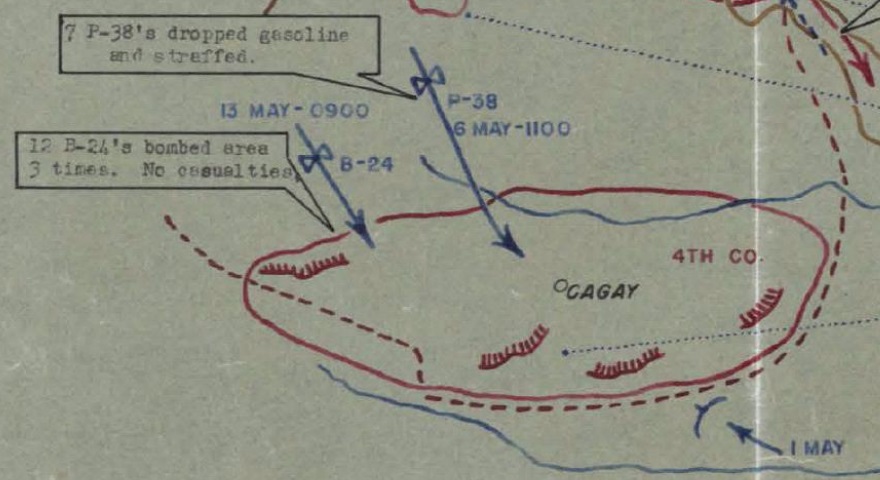

May 5, 1945
Banzai attack:
On May 5, one of the companies ran into a Banzai attack early in the morning. I think they said it was about three o' clock when the first of the estimated hundred Nips started up toward our boys. Luckily, we held the highest ground and they had to fight uphill or I think things would have been much worse.
Before the attack they let loose with their heavy mortars and tore up most of the small hill. In fact nearly all of the men killed then were hit with flying steel fragments. One of our machine gunners, who saw the Nips first, died squeezing his trigger as they weere trying to silence our machine guns first. They used to say that an automatic weapon position was one of the most dangerous places and I know now that it is so. Two boys armed with Browning Automatic Rifles stood up in the face of everything the Nips had and practically stopped the attack. I used to play poker with one of them, Leo Bonte, but I've never met the other one, Don Volgan.
I guess the actual attack didn't last more than forty-five minutes, but let me tell you that we counted it by years. I was talking with Majil Smith, one of the medics who was in it, the other day and he says that if he ever has to go through another one like that he'll probably go completely nuts. I wouldn't blame.him. He saw one fellow get hit by a 90 millimeter shell just about eight feet away. The poor fellow had been trying to move to a bigger hole when he was hit. The force of the explosion smothered Smitty with dirt and when he started up to help the fellow he could see he was dead. He said it sounded more like a clap of thunder than anything he could think of. Smitty did a bang-up job that morning and really deserves the thanks of many men. He gave aid to six men during the attack and cried over the body of another who died in his arms. Death under fire is morel dramatic than any other place and more awful. This one man knew he was going to die and wouldn't let Smitty do much for him. He kept mumbling for him to go and help someone who had a chance to live.
Herman Satory had his third close call when a mortar shell landed between his legs. It was a dud and he was able to tell about it. I told you once about the time he had a 25 caliber bullet go through his helmet and another time when one just skinned his shoulder. Funny thing about freakish luck like his.
I went to Leon the morning after the attack to bring back the dead to Iloilo and had to wait quite awhile. They had set up headquarters in the cement market place and while I waited I talked with some of the boys. We started a small pool on when the war would be over in Europe.
Nine were killed in that fight and they had to be carried back down the mountain and across country for fourteen miles to the trucks which couldn't get any closer. I guess every Filipino for miles around had heard of the fight, for the small town was jammed. Tbere was a lot of talking and jabbering until the first of the dead were brought in and then it was quiet. Tbey paid respect with their silence and for that I admired them. As they brought in the bodies and laid them on the floor the medics began to tag them for identification at the cemetery. One of the fellows was in pretty bad shape and Andy Williams was asked if he knew who it was, Williams had been up at the front and was dirty, bearded and dead tired. He lifted the shelter half from the dead man's face and slowly studied it before the light of recognition flooded his dark eyes. When he told them who it was, as he carefully covered the man and straightened up, his dirty hand moved across his nose and misty eyes. It took a lot out of me and as we drove back I looked at the men whom we were about to bury. It made me realize again how fast life can run out and made me wonder what is worth while in the world. I'm not going to turn philosopher on you, but nevertheless such things do alter one's attitude in many respects and I find myself re-examining myself and the world we live in.
- 160th U.S. Infantry
May 6, 1945
Americans end bombarding Japanese positions with mortars.
Under fire again on the 1st of May (1945).P-38's bomb and strafe Bocari.
These mortar barrages continued until the 6th
- Lt. Sadayoshi Ishikawa
On the 6th, seven P-38's strafed the area and dropped gasoline tanks (Napalm bombs).
- Lt. Sadayoshi Ishikawa
7 P-38's dropped gasoline and straffed (the area of the 4th Company).
- Lt. Sadayoshi Ishikawa (Illustration)
Enemy planes also started strafing. At one time, they even scattered fuel from the air and set it afire, causing the death of several soldiers and leaving the position in flames.
- Lt. Toshimi Kumai

May 7, 1945
Japanese heavy firing.
On the 7th of May, intense machine gun and rifle fire was received from an estimated 150 to 200 Japs in well dug-in positions in the mountains in the vicinity of Bucari, twelve miles northwest of Cabatuan.Japanese attack American supply train.
- 40th Infantry Division
One of our supply trains moving north in the Sibalon River valley 4000 yards northwest of Leon, was attacked by approximately fifteen Japs.
- 40th Infantry Division
May 8, 1945
Japanese encounter on May 8, 1945:
Last night at the dance I met an old friend whom I hadn't seen since we were on New Britain, It's funny how long you go at times without seeing some of your closest friends even though you are only a little way apart. Well Joe, Joe Grammatico is his full name, and I had quite a little bull session and he told me that he and eight others were just about finished on May 8. In fact one of them was killed.
Joe, Earl Scherrer, Joe Krumpack, Stanley Novak, David G. Frank, Walter Wojtasik and Marvin Lawrence were sent out on a patrol to see what the Nips were up to. They were traveling light and didn't carry much ammo since they weren't supposed to fight. One of the men had only one clip--that's eight rounds.
Lawrence was the lead scout and he was as surprised as the Nips when he walked out from some jungle near the top of a hill and saw a whole mess of them sitting in their holes eating rice cakes. Can you imagine eating rice cakes? We fired a few shots and then dived for cover as all of the Nips were getting ready to pour on the works.
The rest of the patrol followed suit finding that they were outnumber~.d five to one. In the brief skirmish one of the men was hit. The Japs were firing machine guns from both flanks and the nine men were catching too much on the chin to stay. They ran back down the hill and stopped at the bottom where they tried to save the ir comrade, but it was too late. I guess the Nips thought they would be able to kill them all as they followed and kept shooting until the men had found cover on the far side of the hill.
That is one of the things that always makes us so mad. Every time we go out in small groups we run into a solid wall of Nips. And, if you take a large patrol it seems like we never find a thing.
- 160th U.S. Infantry
May 9, 1945
Japanese detachment attacks American mortar positions.
Before daybreak on the 9th, a 30-man combat patrol commanded by 2d Lieutenant Fukunori Okudo launched a surprise attack against the (American) mortar positions. When he returned around 0600, he reported that the patrol had inflicted considerable damage while losing only three men. This assault and the capture of some of the American weapons stopped the attacks for the time being.
- Lt. Sadayoshi Ishikawa
1st Lieut. John J. Martin, 160th Infantry Regiment, earns the Purple Heart for wounds and the Silver Star for valor, in Bocari, on May 9, 1945, which read:
“For gallantry in action near Bucari, Panay, Philippine Islands, on 9 May 1945. When his company was subjected to a heavy night counterattack by a large number of the enemy, which overran the perimeter and turned one of their machine guns on the company, First Lieutenant Martin, though wounded by a grenade fragment at the beginning of the attack, left the shelter of his foxhole to reorganize his company. Leading a small group of men, he successfully repulsed the enemy, forcing them to withdraw leaving many dead and wounded. First Lieutenant Martin’s action enabled his company to retain its position, fulfill its mission, and prevent further loss of life of the men under his command.”
John J. Martin
Photo and medal description courtesy of his son, Dick Martin.
springfieldsdveteranscom_john-jack-martin.html
https://www.springfieldsdveterans.com/john-jack-martin.html
Pfc. Harold Edward Sands, 160th Infantry Regiment, killed in action on Panay Island on May 9, 1945.
https://soledadmemorial.org/plaques/private-first-class-harold-edward-sands/
Pfc. Harold Edward Sands, 160th Infantry Regiment, U.S. Army, World War II
Killed in Action on May 1945 in Panay Island. Bronze star, Purple Heart.
Pfc. Horace Lewis Delino, 160th Infantry Regiment, killed in action on May 9, 1945.
Pfc. Frank Diaz, 160th Infantry Regiment, killed in action on May 9, 1945.
May 12, 1945
Four American field cannons are put in place.
Four field cannons are put in place and began blasting Japanese positions, which continued until May 19, 1945
- Lt. Sadayoshi Ishikawa (Illustration)
(Lt. Ishikawa identifies these as 105mm howitzer field artillery positioned five kilometers east of Bocari.)
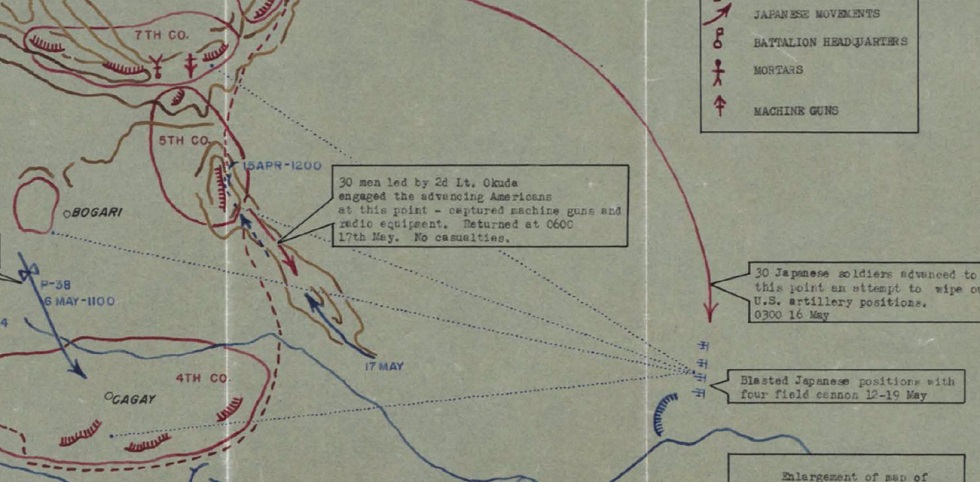
May 13, 1945
The Field cannons bombard Japanese positions.
On the 13th, for the first time, we came under the fire of 105mmm field artillery. This fire came from howitzers which the Americans had moved into position five kilometer east of Bocari.
- Lt. Sadayoshi Ishikawa
(May 13 or) May 14, 1945
B-24 bombers bomb Bocari.
On the 13th of May, eighteen B-24's bombed enemy positions in this area, destroying the fortifications and dispersing the enemy forces.
- 40th Infantry Division
The following day (May 14, 1945) twelve B-24's circled over the area and bombed the battalion positions.
- Lt. Sadayoshi Ishikawa
12 B-24's bombed area (of 4th Company) 3 times. No (Japanese) casualties.
- Lt. Sadayoshi Ishikawa (Illustration)

May 14, 1945
Americans pierce Japanese forward positions.
The situation became serious when the enemy pierced our forward positions on the 14th.Japanese anticipate and prepare for an American final all-out assault.
- Lt. Sadayoshi Ishikawa
Orders were issued in anticipation of a final, all-out assault.
- Lt. Sadayoshi Ishikawa
May 16, 1945
Japanese detachment advance to neutralize the four field cannons:
30 Japanese soldiers advanced to a point on attempt to wipe out the U.S. artillery positions 0300 16 May.Battle at mountain ridges:
- Lt. Sadayoshi Ishikawa (Illustration)
(These four American field cannons were blasting Japanese positions from May 12 to May 19, 1945.)
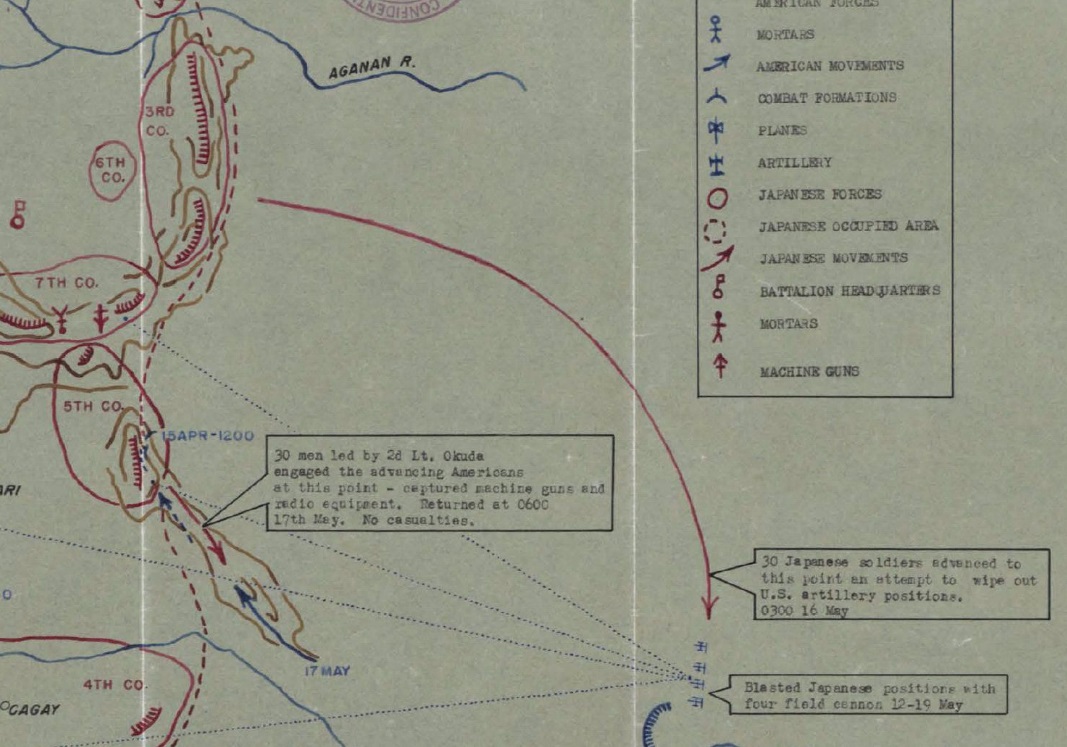
Dear Family:Tozuka reminds them later of this battle, after the Japanese surrendered.
* * *
"I wanted to be sure and tell you about one of our last fights. I think it took place on May 16 as that was the day i received the last letter i had from you in more than ten days. Something must have happened to the boats coming this way since they started fighting up north.
I know that you must think by now that all we do is get trapped by the japanese, and i guess it's just about the truth. They keep telling us that there are only a few hundred left, but we know better as they are in too many places at once in too great numbers. However, you just can't tell higher headquarters any thing once they've made up their mind -- or before for that matter -- and so we'll just have to stick it out. that's what these guys were doing on twin nob hill when they got shot up ... just trying to stick it out against something they couldn't control these men were in the middle of a well organized sniper party of at least thirty Japanese.
Bill Roberts, Gayle Hillkirk and Al Stout were some of the men subjected to the mental torture of sweating out the next shot coming from 'nowhere'. The nips had allowed them to get up between two ridges before they started to pick off anyone who stopped moving. That was one of the strange things. the "good book" says to stop and find concealment and cover when under fire. but, this time, there was only one salvation and that was to keep moving as fast as you could. three men were wounded. they stopped one second too long. Another man was killed when he stopped two seconds too long.
The men knew they couldn't fight the hidden snipers and tried to get out with their lives. It took them nearly an hour to escape from the valley by dodging from tree to tree. They had to make sure their next stop would be behind a tree thick enough for protection, and, of course, the nips used all kinds of ruses to trick them. one of the medics, george meinders, was struggling to keep himself alive as well as the wounded when he heard a voice calling, "hey Joe -- Joe, hey Joe." It sounded like a wounded american and he stopped to look around. Not being able to locate the caller, he started to run again and slipped in the mud. His head jerked forward as he nearly went to the ground, and a Japanese sniper's bullet whistled past and thudded into a tree where his head had been."
- 160th U.S. Infantry
"You remember when you were fighting us early in may near leon? you lost quite a few men when you tried to take one ridge. I had a good notion to let you have that ridge as my men were on ridges on each flank and then we were going to surround and kill you before we retook iloilo. We could have done it as we had 1800 men but you thought we had only a few. Am I right?"Dudley D. Holt, 160th U.S. Infantry, killed in action at Bocari on May 16, 1945.
- Lieut. Col. Ryoichi Tozuka
To this question our boys could only stare and wonder how close to certain death they had been.
- 160th U.S. Infantry
May 17, 1945
HOLT, DUDLEY D., Pfc., son of Hale Holt, Timpson. Entered Army, 1942, trained in Hawaii. Served on Luzon and S. Pacific. Awarded GC Medal, Pacific Medal, Purple Heart. Killed in Action on Buccri Panay, Philippine Island, 1945.
http://www.shelbycountytexashistory.net/military/mil_memorial.htm

Americans advance.
Americans advance towards the position of the 5th Company.Okuda volunteers to storm the Americans.
- Lt. Sadayoshi Ishikawa (Illustration)
We kept passive while the US forces led the war. Not content to wait out for the one-sided attack, however, some forces volunteered to storm the enemy at night. The unit commander ordered the Yoshioka force to do this since it had a lot of combat experience. For this purpose, 2nd Lieutenant Okuda volunteered to be the commander of the Raiding Unit.Okuda engages the Americans.
- Lt. Toshimi Kumai.
On the night of the raid, at around 2 a.m., we heard fierce shooting towards the American position that lasted for some time before the stillness returned.Okuda returns.
- Lt. Toshimi Kumai.
30 men led by 2d Lt. Okuda engaged the advancing Americans at this point - captured machine guns and radio equipment.
- Lt. Sadayoshi Ishikawa (See illustration)
30 men led by 2d Lt. Okuda engaged the advancing Americans at this point - captured machine guns and radio equipment.Ishikawa illustration about this raid.
- Lt. Sadayoshi Ishikawa (See illustration)
Returned at 0600 17th May. No Japanese casualties.
- Lt. Sadayoshi Ishikawa (See illustration)
In the morning, Captain Yoshioka came out smiling broadly with several US ration tins. They had also captured batteries for the wireless radio and transceiver or walkie-talkie.
- Lt. Toshimi Kumai.
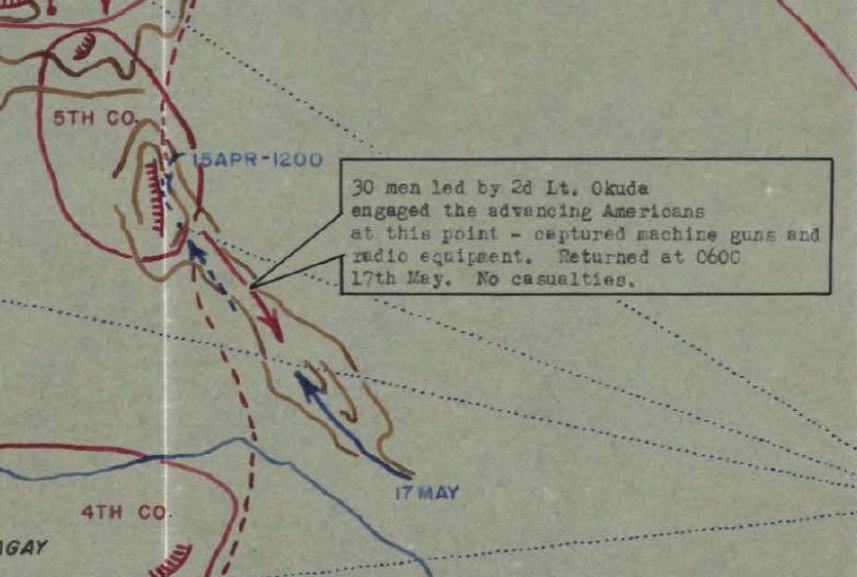
May 19, 1945
Anticipated American all-out assault does not materialize.
(The all-out assault expected since May 14, 1945) however, did not materialize.Americans withdraw.
- Lt. Sadayoshi Ishikawa
Instead, on May 19th, the Americans withdrew.The four field cannons are withdrawn.
- Lt. Sadayoshi Ishikawa
Subsequent to this (May 14, 1945) air strike, no major contacts were made with Jap troops and the elements of the 2nd Battalion, 160th Infantry, withdrew to the Iloilo Plain for garrison and training activities.
- 40th Infantry Division
The four American field cannons that were blasting Japanese positions from May 12, 1945 were apparently withdrawn on this day.2nd Battalion 160th Infantry Regiment attacks on Bocari cease altogether.
- Lt. Sadayoshi Ishikawa (Illustration)

The Panay (Japanese) garrison had undergone, beginning about mid-April, intermittent enemy ground assaults supported by air and artillery bombardment. These attacks ceased altogether in late May.
- Reports of Gen. MacArthur, Japanese Operations in the Soutwest Pacific Area
After the fighting at Bocari
2nd Battalion 160th Infantry Regiment continue patrol actions.
Only patrol action was continued to investigate reports of Jap foraging parties and to destroy those groups which attempted to descend into the lower plain.Japanese continue to obtain food supplies.
- 40th Infantry Division
After the withdrawal of the Americans in May we had practically no casualties although there were numerous artillery barrages delivered on our positions. The bocari area abounded with ridges and depressions ideally suited for the defense. In view of the terrain and the resultant difficulty of executing mechanized maneuvers, I believe that we could have carried on our defense indefinitely had our ammunition and food supply held out.
- Lt. Sadayoshi Ishikawa
The American habit of assaulting an objective only after a thorough preparatory fire, although highly effective, did not produce annihilation as it alerted us and provided time to withdraw before an impending attack could be launched. Our inability to win a single engagement was caused, to a considerable degree, by the poor quality of Japanese weapons as compared to the unvarying excellence of the American arms.
- Lt. Sadayoshi Ishikawa
Subsequent action was limited to patrol engagements and endeavors to raise vegetables in an attempt to become self-sustaining.
- Lt. Sadayoshi Ishikawa

|
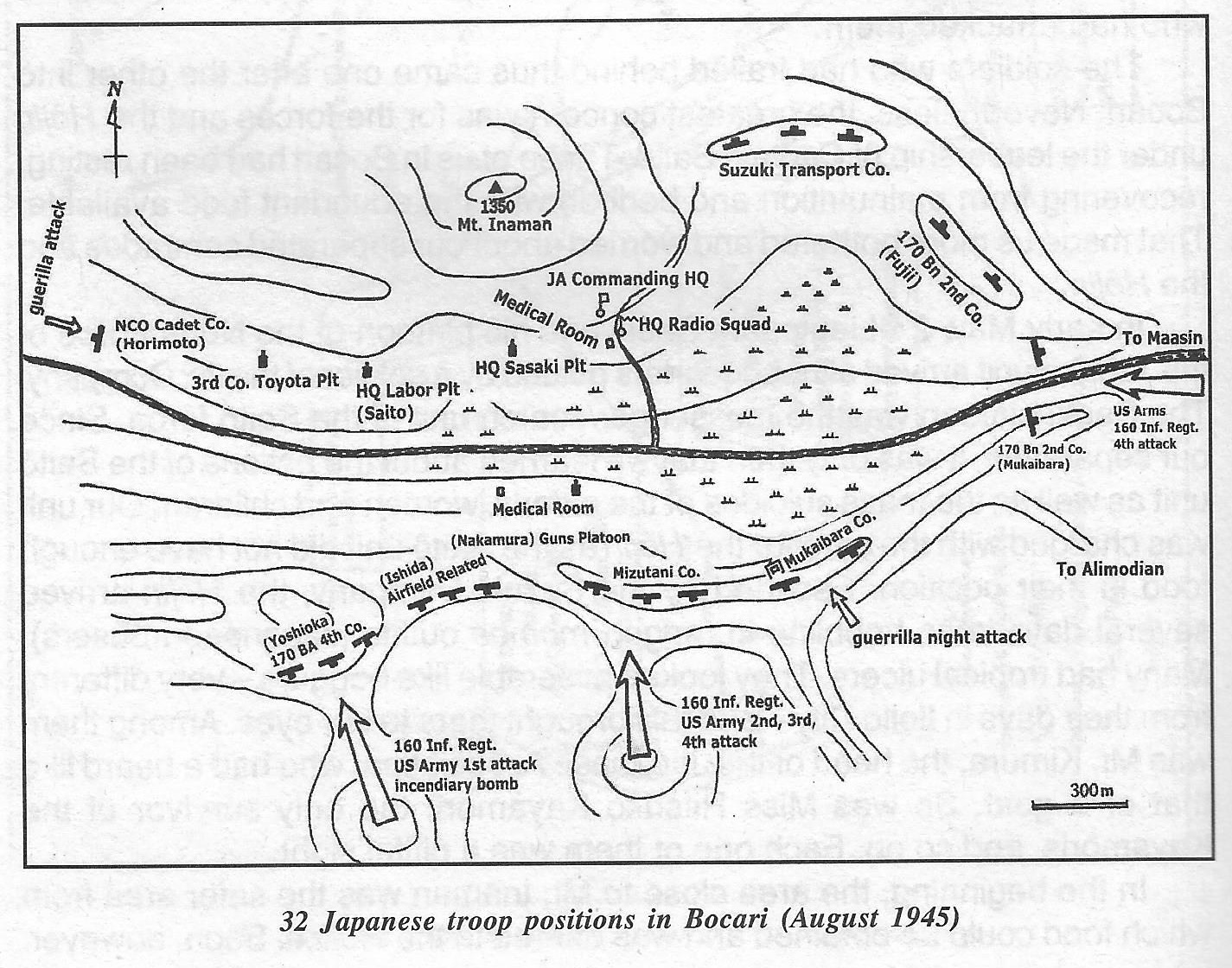
|
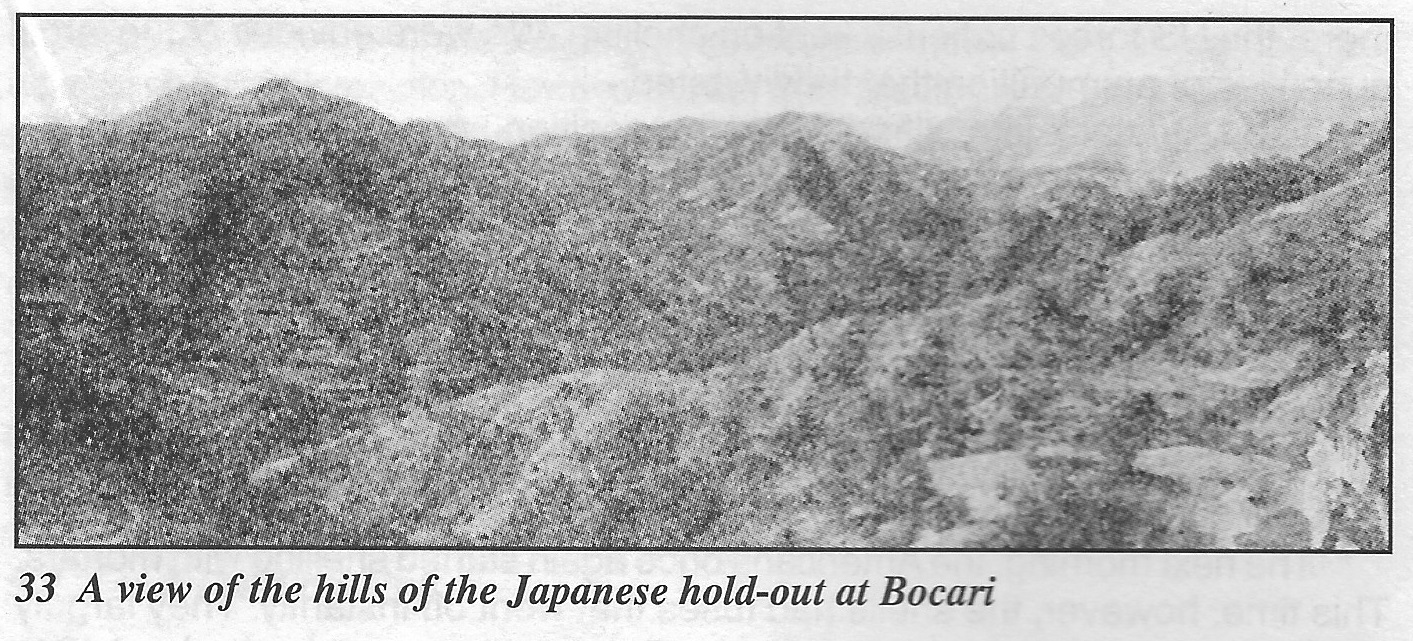
|

|
Japanese officers under the direct command of Lt. Col. Ryoichi Tozuka while they were in the mountains in Bocari:

Just below Mt. Inaman current terrain map 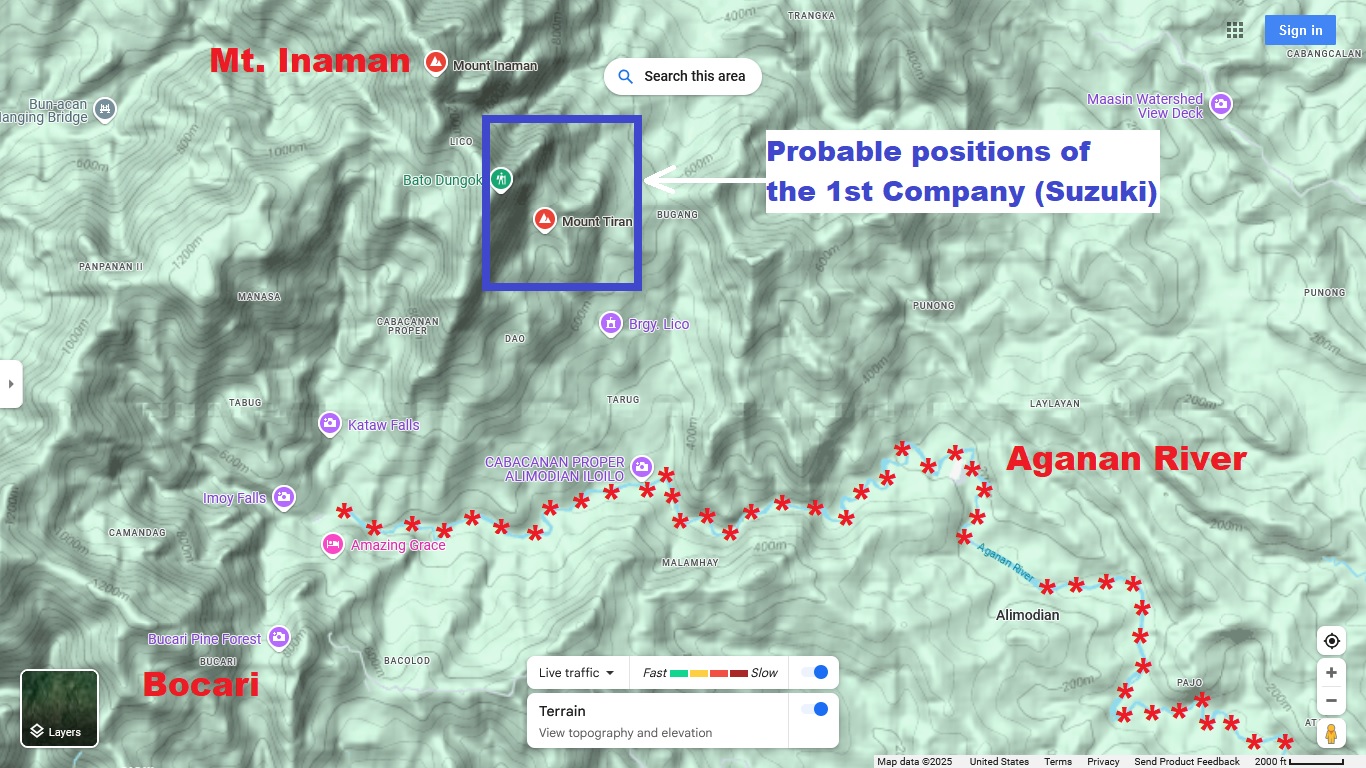
Ishikawa map curiously, Mt. Tiran is on the left side of Mt. Inaman on the this Ishikawa map while on the current terrain map, Mt. Tiran is on the right of Mt. Inaman 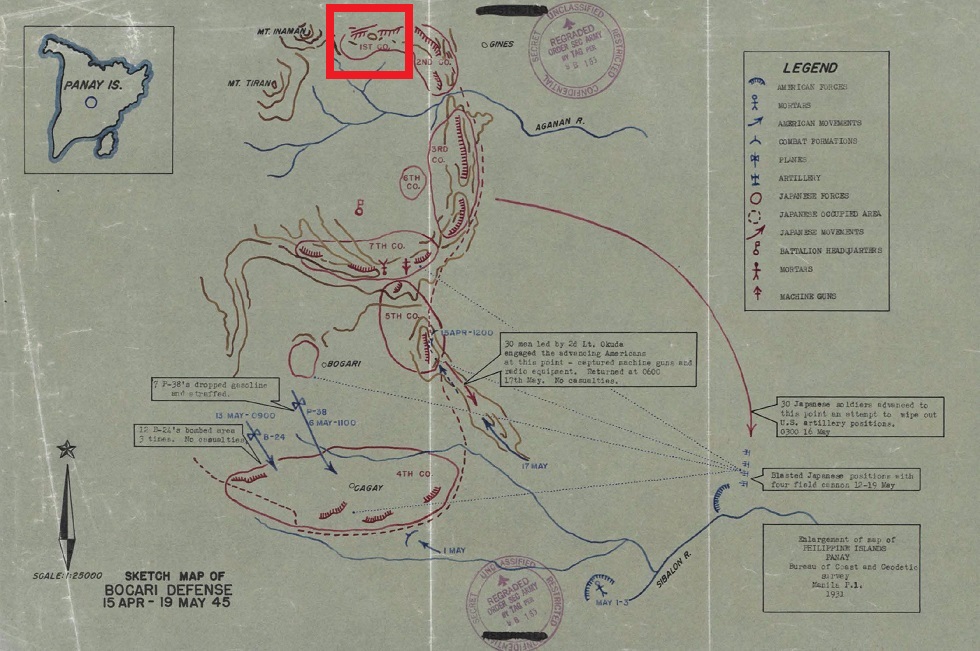
Kumai map 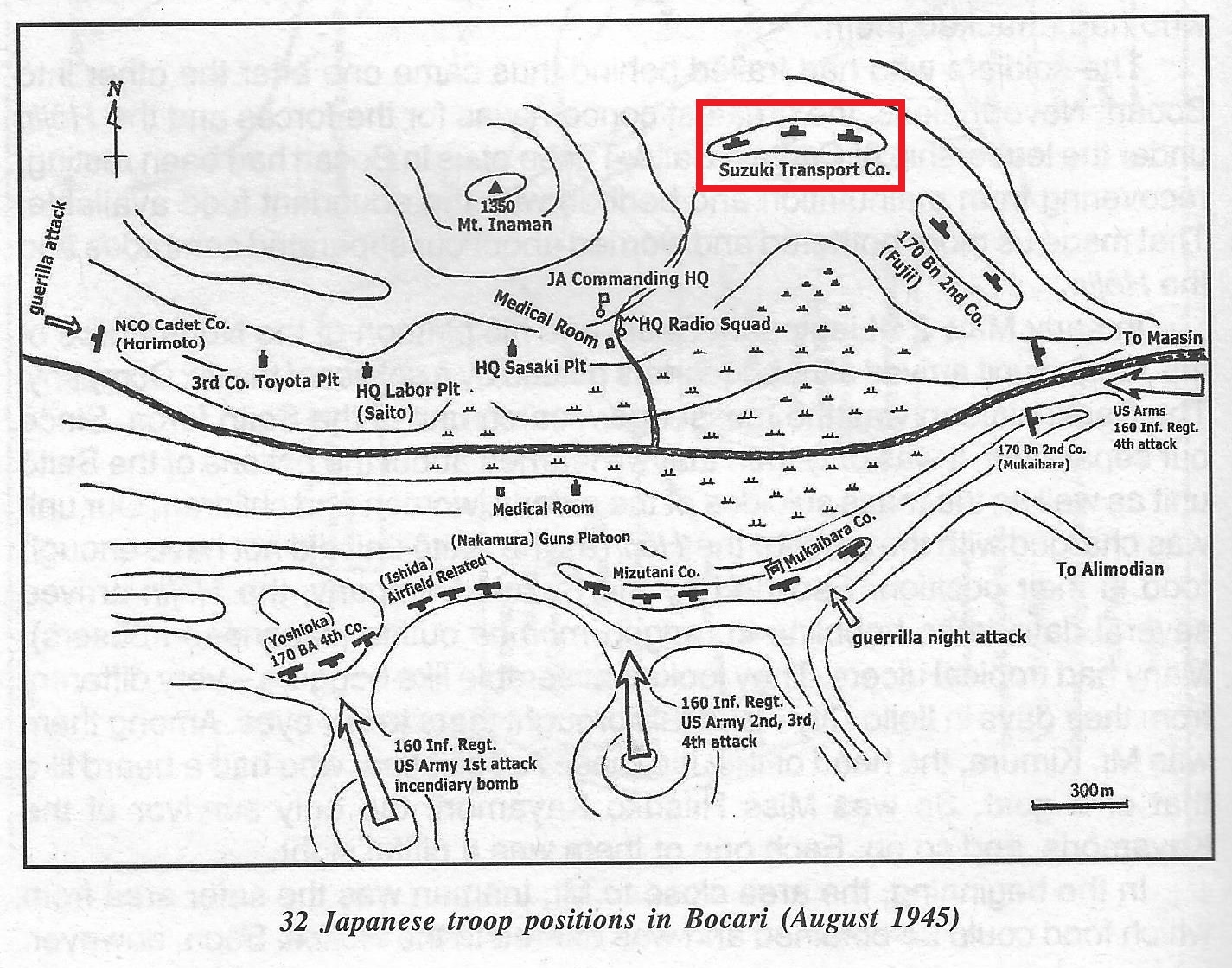

Just above Aganan River current terrain map 
current terrain map showing "Gines" to the right, which appears on the Ishikawa map 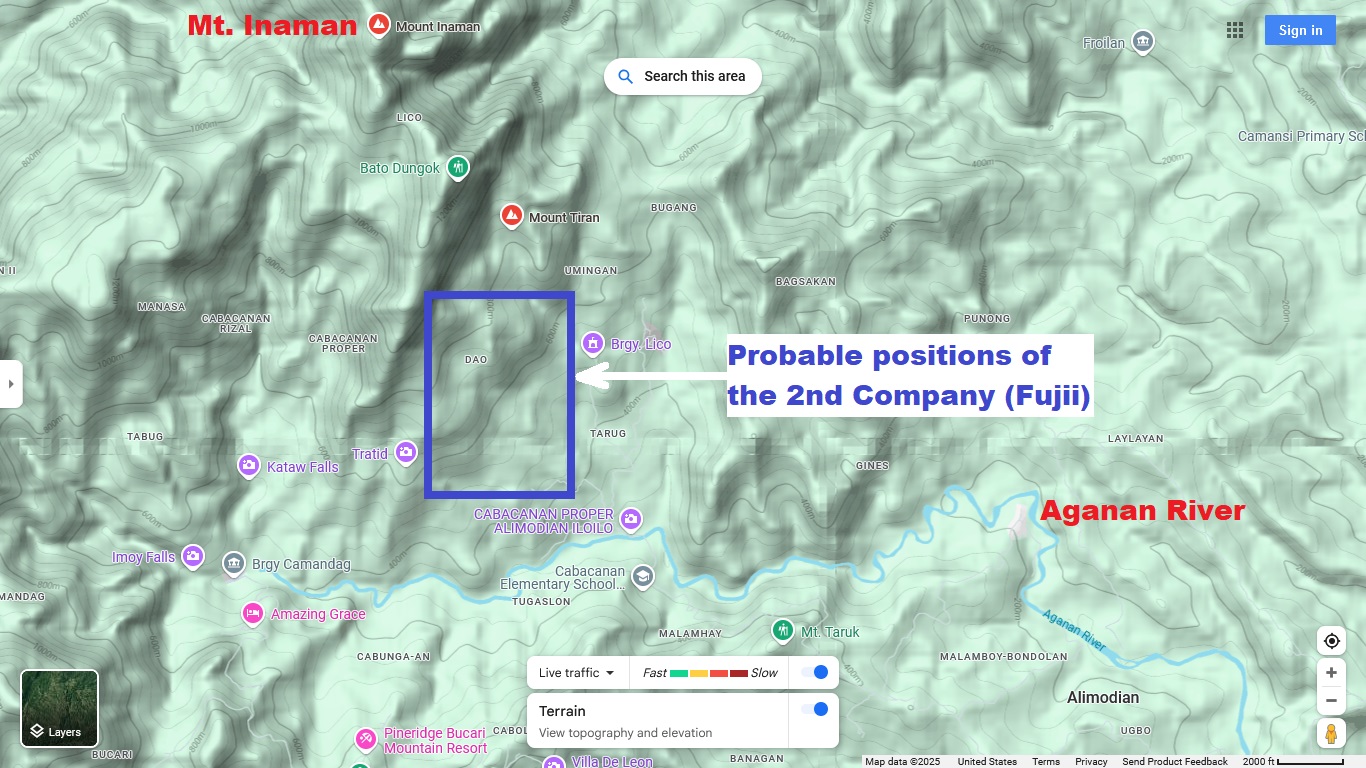
Ishikawa map 
Kumai map 

On Mt. Cagay, below Bocari, surrounded by the Sibalom River current terrain map 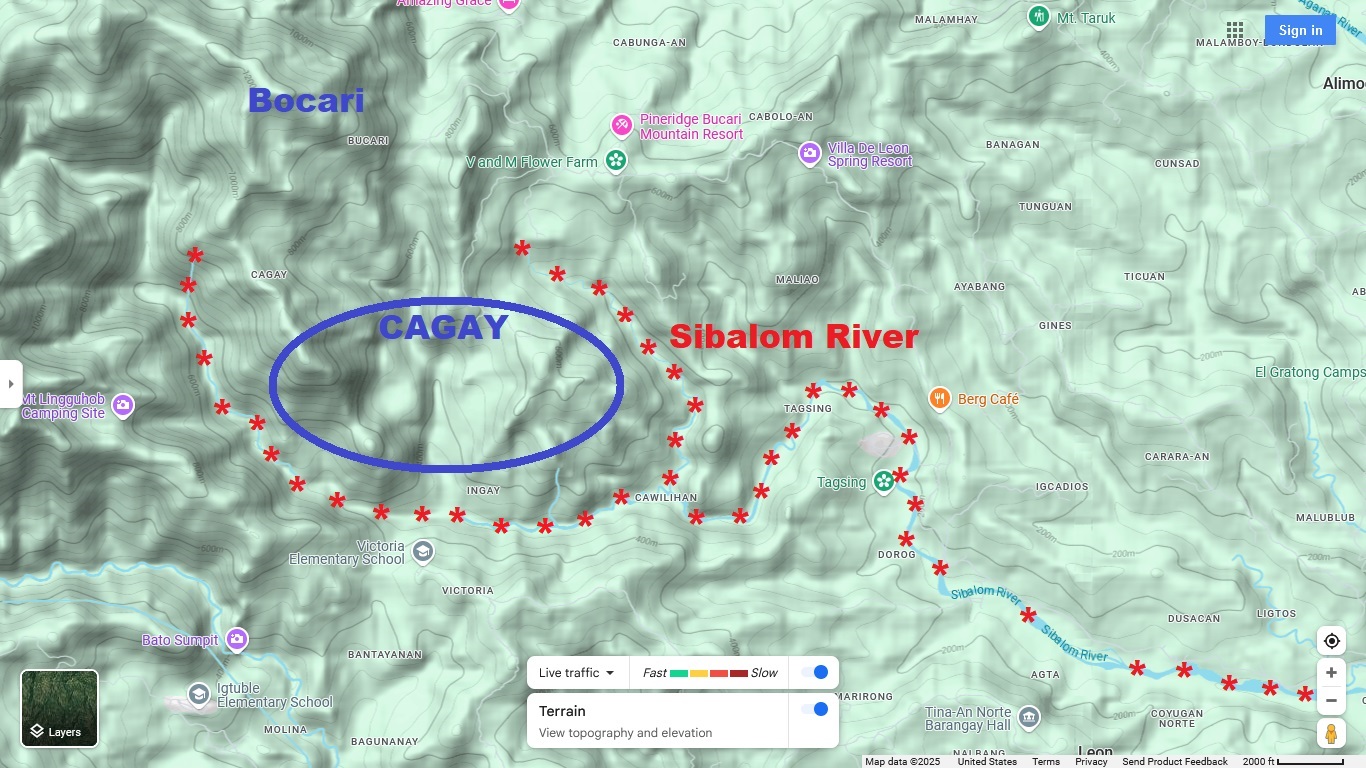
Ishikawa map 
Kumai map 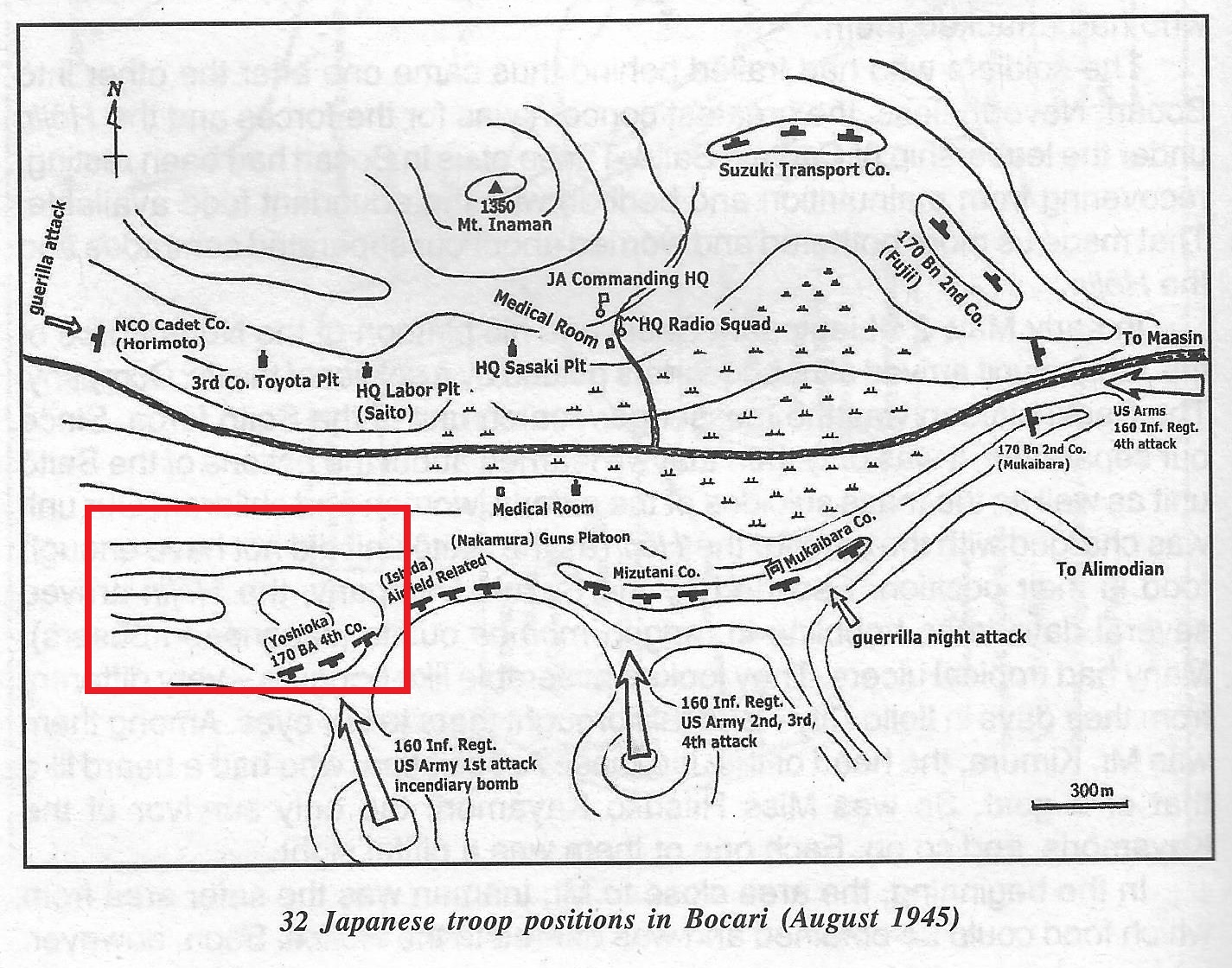

|

